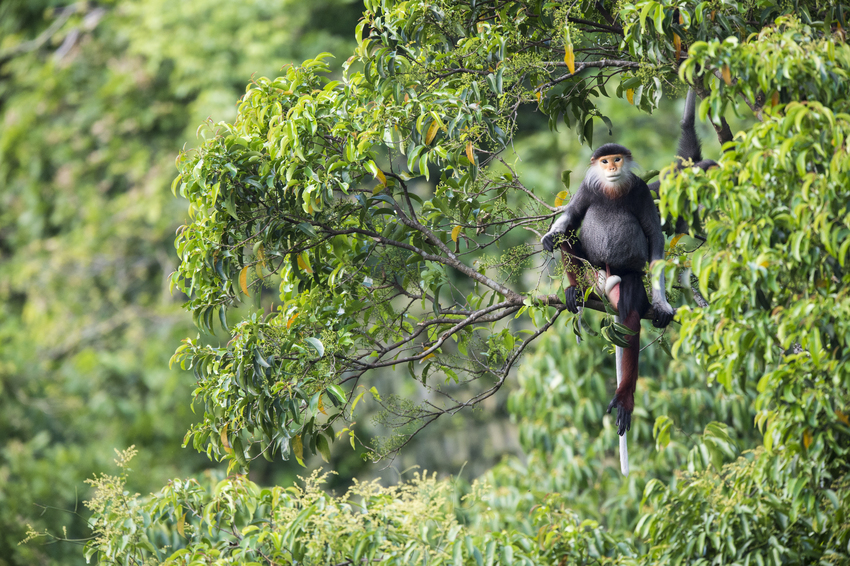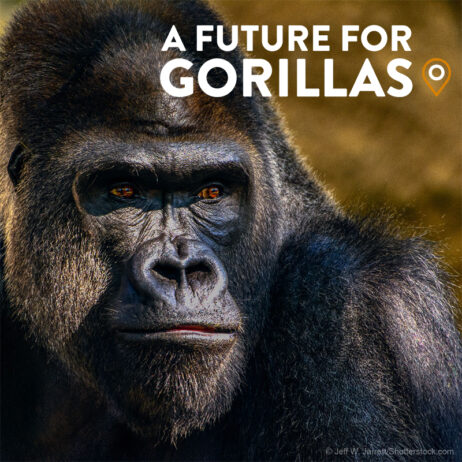
Forest restoration at Khe Nuoc Trong is giving a new lease of life to land torn by the Vietnamese-American war, creating a chance to see again the rare Saola antelope. Image credit: ©David Bebber
Renewed commitment from Vietnam’s state will help rescue singing gibbons and one of the world’s rarest mammals from the brink of extinction, bringing closer the vision of a late conservationist who fought to revive forests torn by the Vietnamese-American War.
The Quang Binh Provincial People’s Committee has now upgraded the Watershed Protection Forest (WPF) of ‘Dong Chau – Khe Nuoc Trong’ to a Nature Reserve bearing the same name, delivering a victory to local conservation body Viet Nature Conservation Centre (Viet Nature).
Supported by World Land Trust (WLT), BirdLife International, IUCN National Committee of the Netherlands (IUCN NL) and the University of Leeds, Viet Nature has worked since the early 2010s to protect the Khe Nuoc Trong forests, one of the best and last few such ecosystems still standing in Vietnam and the home of over 40 threatened animal species.
Khe Nuoc Trong’s 22,132-hectare tract of Annamite lowland evergreen forests will majorly benefit from the new nature reserve status, according to Viet Nature President and Co-founder Pham Tuan Anh.
“Whilst the watershed protection status already protected the trees from logging, it didn’t have any mandates for wildlife conservation,” Tuan Anh says. “The new status puts biodiversity protection as a key objective – the level that its outstanding biodiversity deserves. It’s an inspiring achievement after more than a decade of hard work. We will now be able to access a higher level of funds for conservation from local as well as national governments.”
A new chance for extinction-facing ‘Asian unicorn’
As WLT Conservation Director Richard Cuthbert explains, the hope is that the new nature reserve status will pave the way for forests to regenerate in the long run – a lifeline for the astounding array of wildlife that calls Khe Nuoc Trong home.
The reserve’s biodiversity value is illustrated by its roster of key animal species, from charismatic primates – chief among them the Red-shanked Douc Langur and the singing Southern White-cheeked Gibbon – to the spectacular (and Endangered) peacock-like Crested Argus birds and a great many turtle species.
For some species, continued protection of Khe Nuoc Trong and similar forests may offer a last chance. Discovered only in 1992, the Saola antelope is one of the world’s rarest mammals, earning it the ‘Asian Unicorn’ nickname. The reserve is a likely habitat of this Critically Endangered species, driven by poaching to the cusp of extinction.
Khe Nuoc Trong could prove key to the fate of other extinction-facing species in the area, including a Critically Endangered deer species – the Large-antlered Muntjac – known to science only since 1994. The Vietnam (or Edwards’) Pheasant, a Critically Endangered bird not seen in the wild for decades, may be reintroduced in the nature reserve in the future.

Visiting Khe Nuoc Trong in 2013, WLT’s late conservationist Roger Wilson was instantly struck by the value of protecting these forests. Image credit: ©Mark Stanley Price
The vision of late forest champion Roger Wilson
Khe Nuoc Trong’s new status brings posthumous recognition to the vision of late conservationist Roger Wilson, who believed in the reserve’s game-changing potential from the get-go.
Viet Nature’s Tuan Anh remembers Wilson’s first visit to the area in early 2013, four years before his untimely passing. The then-WLT Conservation Director was thrilled by the wildlife pictures coming through from camera traps, Tuan Anh explains, adding: “He immediately became convinced of the global importance of the site, and the urgency of protecting it.”
“At the time, Roger told me that he’d been working for over 40 years across the world and found the Vietnam forests really exceptional. I think he would be very happy if he heard this news today,” Tuan Anh remarks. She adds that Vietnam’s current approach to seldom declare new protected areas makes moves like Khe Nuoc Trong’s new status “very, very special.”
Those working with Wilson in the past have celebrated his ability to “understand local aspirations” in the conservation projects he championed. At Khe Nuoc Trong, such a spirit will live on: Viet Nature’s strategy now focuses on fostering alternative livelihood options for those engaging today in illegal logging and hunting.

An endangered Red-shanked Douc Langur (Pygathrix nemaeus) photographed in Khe Nuoc Trong, – Copyright Bjornolesen.com/Viet Nature
New lease of life for conservation, communities and climate at former war ground
The cause for a protected Khe Nuoc Trong may bring some solace to a land torn, decades back, by the Vietnamese-American war. Over in the Quang Binh province, the Annamite lowland forest will grow stronger at a spot not far from the old border between North and South Vietnam.
From such a momentous location, the Khe Nuoc Trong reserve will also help humankind in a greater, global fight – that against climate change.
The 22,132 hectares of forest are a climate powerhouse in their own right: according to research by the University of Leeds, protecting the reserve could offset almost 50,000 tonnes of carbon dioxide per year over the next 30 years. With the help of WLT’s Carbon Balanced programme and others, this potential can be maximized to support ongoing conservation efforts. Viet Nature’s work at Khe Nuoc Trong is also supported by BirdLife’s Forest Landscape Sustainability Accelerator, an initiative that contributes to the Trillion Trees vision of one trillion trees re-grown, saved from loss, and better protected around the world by 2050.
At Khe Nuoc Trong, the decades-long push for nature continues today. With Vietnam’s government, Viet Nature and the communities at the steering wheel, all partners will ensure people and planet both thrive from the work at the new nature reserve – further advancing Roger Wilson’s vision. “Without WLT, BirdLife International, IUCN NL, the University of Leeds, and all our supporters like The Body Shop this success would not have been possible,” Tuan Anh says. “Viet Nature will be present at the site for the long haul to protect and pass on this gem to future generations.”
